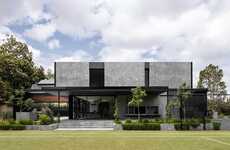
Shlomit Mamon Zaresky Works on a Building That is About 400 Years Old
Kalin Ned — February 5, 2020 — Art & Design
References: shlomitmamon & design-milk
It is usually rather unusual for a cave-like home to be brightly lit, but this is not the case with this abode, which is situated on the grounds of the Old City of Jerusalem — a location that is said to be "tricky for contemporary architects." This stems from the historic value of the place, which is riddled with ruins, vaults, and more.
Shlomit Mamon Zaresky was tasked with renovating a home that was approximately 400 years old. This proves to be an exciting task, as well as a sizable challenge, for the contemporary architect. The cave-like home, which spans between two street levels, exhibits a cozy, intimate, and private interior. During the refurbishing process, Shlomit Mamon Zaresky emphasized light sources and the relationship between historic and modern aesthetics.
Image Credit: Gideon Levin
Shlomit Mamon Zaresky was tasked with renovating a home that was approximately 400 years old. This proves to be an exciting task, as well as a sizable challenge, for the contemporary architect. The cave-like home, which spans between two street levels, exhibits a cozy, intimate, and private interior. During the refurbishing process, Shlomit Mamon Zaresky emphasized light sources and the relationship between historic and modern aesthetics.
Image Credit: Gideon Levin
Trend Themes
1. Bright Cave-like Homes - Creating cave-like homes that are brightly lit offers a disruptive innovation opportunity to blend historic architecture with modern aesthetics.
2. Renovating Historic Buildings - The renovation of 400-year-old homes presents a disruptive innovation opportunity to preserve historical value while incorporating modern design elements.
3. Balancing Intimacy and Modernity - Finding the right balance between intimate and private interiors with contemporary design concepts presents a disruptive innovation opportunity in home renovation.
Industry Implications
1. Architecture - Architects can explore disruptive innovation opportunities in preserving historical buildings while incorporating modern and sustainable design principles.
2. Interior Design - Interior designers can bring disruptive innovation to the table by successfully integrating historic architecture and modern aesthetics in renovating old homes.
3. Historical Preservation - The field of historical preservation can benefit from disruptive innovation by finding creative ways to maintain the historical integrity of buildings while meeting modern design standards.
4.8
Score
Popularity
Activity
Freshness























